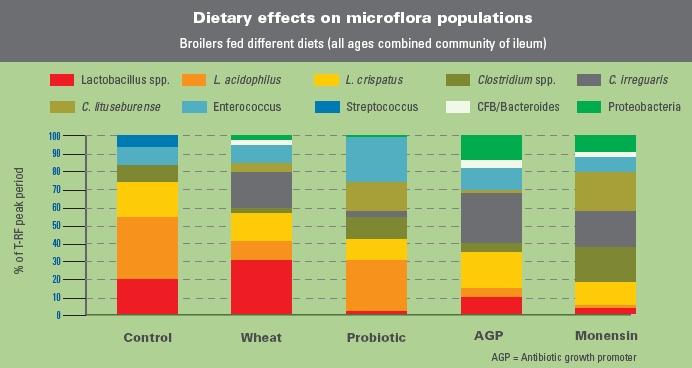
Collett: 'Avoid perfect conditions for necrotic enteritis to develop'
 "We know that
clostridial organisms in the small intestine, once they get access to nutrients, can replicate very quickly."
"We know that
clostridial organisms in the small intestine, once they get access to nutrients, can replicate very quickly."
DR. STEPHEN COLLETT
Poultry producers who want to improve
bird performance through natural means
should bone up on the chicken's anatomy,
says Dr. Stephen Collett, a nutritionist and
professor at the University of Georgia.
At the Orlando meeting, Collett gave the
audience a quick and practical overview of
chicken anatomy, focusing on the digestive
tract. His talk made it clear that growers
who develop a better understanding of gut
anatomy and put that knowledge to use
can produce healthier birds and grow
them faster.
Collett emphasized that early physiologic
development of a bird is crucial for
ensuring good growth throughout its life.
"That includes the development of normal
intestinal flora and then getting a good
interaction between the flora and the
microvilli that line the intestinal tract,"
he said.
Microvilli are the tiny, hair-like structures
that do most of the work of absorbing
nutrients from food. They can be very
significantly damaged early in life by toxins
produced by Clostridium perfringens, the
organism that causes necrotic enteritis
(NE). When that kind of damage occurs,
the bird's ability to absorb food is seriously
compromised and it may never fully recover
and meet its genetic potential in terms of
performance or efficiency.
Cecum plays an important role
Collett pointed out that even though the
upper part of the digestive tract—the
ileum or small intestine—does much of
the work of absorbing nutrients from food,
the other end of the tract—the cecum—plays an important role, too.
 Figure 1.
Figure 1. Different types of diets can produce markedly different populations of microflora in the gut of a chicken.
"The hind part of the gut, or the cecum, is
much more sensitive to antigenic stimulation,"
he said. "When we feed various kinds
of diets to birds early on, it's very important
to consider not only the digestibility of the
proteins those feeds contain, but also the
solubility of the protein. That's because
soluble protein will move through the gut
much more rapidly."
Why is that important? Collett explained
that proteins moving through the gut quickly
have less time to be digested. The result
is that relatively large protein molecules
arrive in the cecum and can stimulate an
immune response, which in turn can
cause inflammation.
When birds have an inflammatory response
in the cecum, they shunt food back into the
small intestine—a process that creates
a potentially dangerous situation. "We
know that clostridial organisms in the small
intestine, once they get access to nutrients,can replicate very quickly," he said. "And
in this rapid growth phase, they produce a
tremendous amount of toxin. This creates
perfect conditions for necrotic enteritis
to develop."
Collett explained that different types of
diets could produce markedly different
populations of microflora in the gut of
chicken (Figure 1). He emphasized that
by paying attention to food quality — for
example, supplying young broilers with a
healthy mix of soluble and non-soluble
proteins in their feed—growers can help
maintain a healthy mix of intestinal flora
and minimize problems with NE.
How can producers tell what's in the
intestinal flora of their flocks?
Regular posting sessions can help, Collett
said. "When you see ceca contents that
are pasty, that means you probably have a
significant number of organisms present,"
he said. "When the contents are more
watery, that indicates fewer organisms."
Collett emphasized that the initial colonization
of the chick's gut begins the moment
it's placed on the floor of the house,
where it's immediately challenged with
an enormous number of organisms. "Those
organisms are derived from the previous
cycle's gut flora," he explained. "If we
change the gastrointestinal flora in our
birds, it's going to change the flora in the
whole house over time."
The impact of changes in house flora isn't
usually easy to spot, at least immediately,
Collett said.
"It's a replacement/displacement," he
explained. "But these kinds of changes are
very important, particularly when you're
talking about removing antibiotics from
your operation."
Lessons from niche-marketers
In an interview following his presentation,
Collett was asked to elaborate on that last
point: What sorts of practical lessons about gut health have been gained from the
experience of niche marketers—growers
who have several years' experience
producing antibiotic-free broilers?
He said several lessons could be learned.
First, and perhaps most importantly, these
producers have demonstrated that it is,
indeed, possible to produce broiler meat
as efficiently without antibiotics as it is
with antibiotics.
Second, he said niche marketers have
learned that when growing broilers without
antibiotics, they have to pay considerably
more attention to maintaining healthy
intestinal flora.
"In the past, we've been able to use
antibiotics to suppress the population of organisms migrating back up from the
cecum to the small intestine," Collett
explains. "But now [without antibiotics],
we have to monitor and regulate the cecal
population, so that we don't get that
migration up the tract."
Collett suggested that vaccination could be
a useful tool for managing disease without
antibiotics. "I think vaccination is a very
important part of the drug-free approach,"
he said, "particularly during the transition
phase when you're trying to move away
from antibiotics and anticoccidials."
He emphasized that, unlike drugs, which
may be toxic or alien to the bird's natural
physiology, vaccines work by triggering
a normal immune response against
disease organisms.
"They're the natural way to go."
Spring 2008
Back to North American Edition (#1)











